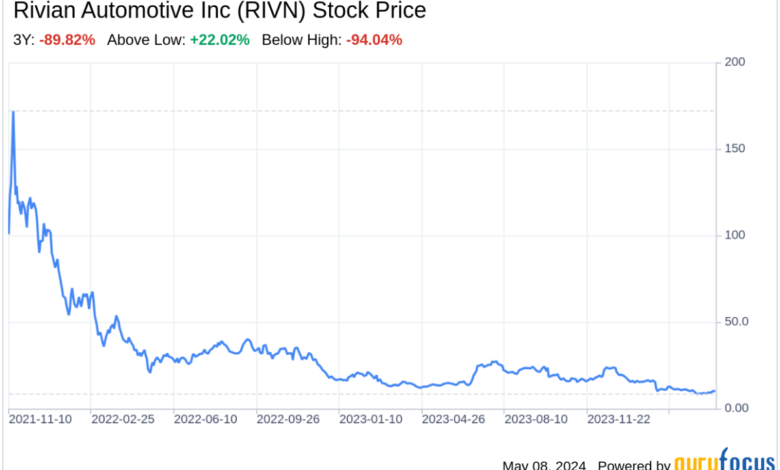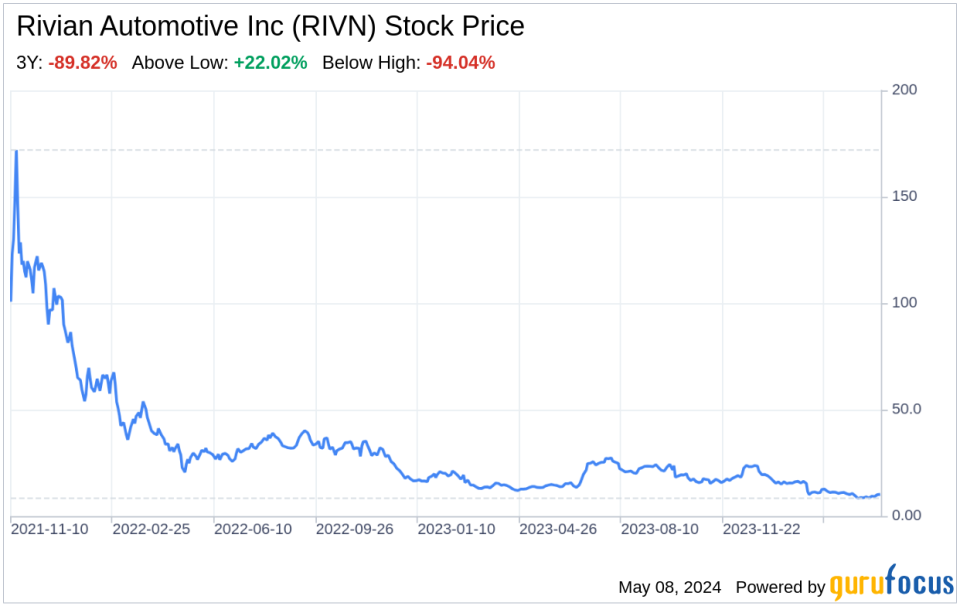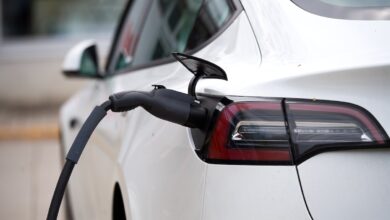Decoding Rivian Automotive Inc (RIVN): A Strategic SWOT Insight

-
Understanding Rivian’s competitive edge in the electric vehicle market.
-
Assessing Rivian’s financial trajectory and operational challenges.
-
Exploring Rivian’s market opportunities amidst evolving industry dynamics.
-
Identifying external threats that could impact Rivian’s growth strategy.
Rivian Automotive Inc (NASDAQ:RIVN), a pioneer in the electric vehicle (EV) industry, has presented its latest SEC 10-Q filing on May 7, 2024, offering a glimpse into its financial performance and operational dynamics. The company, known for its innovative R1 platform, including the R1T pickup truck and R1S SUV, has reported a significant revenue increase from $661 million to $1,204 million year-over-year. Despite this growth, Rivian continues to face challenges, as evidenced by a net loss widening from $(1,349) million to $(1,446) million and an increase in total operating expenses from $898 million to $957 million. These figures underscore the company’s aggressive investment in research and development, as well as selling, general, and administrative expenses, reflecting its commitment to innovation and market expansion. However, the increased loss from operations and net loss per share indicate that Rivian must navigate the complexities of scaling production and managing costs to achieve profitability.

Strengths
Innovative Product Lineup and Brand Recognition: Rivian Automotive Inc (NASDAQ:RIVN) has established itself as a leader in the EV market with its category-defining vehicles. The company’s R1 platform has garnered significant attention for its blend of performance, utility, and sustainability, positioning Rivian as a brand synonymous with adventure and innovation. The R1T and R1S models have not only captured the imagination of consumers but have also received critical acclaim, enhancing Rivian’s brand equity and customer loyalty. This strong brand recognition is a testament to Rivian’s ability to differentiate itself in a competitive market and lays the foundation for future product launches and market expansion.
Robust Financial Growth: Rivian’s impressive year-over-year revenue growth from $661 million to $1,204 million reflects the company’s ability to scale its operations and meet market demand. This financial trajectory, despite the widening net loss, indicates a growing consumer appetite for Rivian’s EVs and a willingness to invest in the company’s vision. The increase in revenues suggests that Rivian is successfully converting its innovative designs and technology into tangible sales, a strength that is crucial for long-term sustainability and market penetration.
Weaknesses
Escalating Losses and Cash Burn: Rivian’s financials reveal a concerning trend of escalating losses, with net loss increasing from $(1,349) million to $(1,446) million. The company’s aggressive spending on research and development, as well as administrative expenses, underscores its commitment to innovation and growth but also highlights the significant cash burn that accompanies such endeavors. This financial strain is exacerbated by the competitive pressures of the EV market, where continuous investment is required to stay ahead. Rivian must address these financial weaknesses by streamlining operations, optimizing costs, and improving production efficiency to move towards profitability.
Operational Challenges in Scaling Production: Rivian’s operational expenses have risen from $898 million to $957 million, indicating the challenges associated with scaling production to meet the increasing demand for its vehicles. The company’s ambitious growth strategy necessitates substantial capital investments in manufacturing facilities, supply chain management, and workforce expansion. However, these investments have yet to translate into a proportional increase in production capacity, leading to higher per-unit costs and impacting the company’s ability to achieve economies of scale. Rivian must overcome these operational hurdles to enhance its manufacturing capabilities and reduce the cost of revenues.
Opportunities
Expanding EV Market and Consumer Adoption: The global shift towards sustainable transportation presents a significant opportunity for Rivian. As consumer awareness and demand for EVs continue to rise, Rivian is well-positioned to capitalize on this trend with its established brand and product lineup. The company’s focus on innovation and customer experience aligns with the evolving preferences of environmentally conscious consumers, providing a platform for Rivian to expand its market share and foster customer loyalty.
Strategic Partnerships and Government Incentives: Rivian has the opportunity to leverage strategic partnerships and government incentives to accelerate its growth. Collaborations with key industry players can enhance Rivian’s supply chain, technology development, and market reach. Additionally, government incentives for EV manufacturers and consumers can lower the barriers to EV adoption, making Rivian’s vehicles more accessible and attractive to a broader audience. By seizing these opportunities, Rivian can strengthen its competitive position and drive long-term success.
Threats
Intensifying Competition and Market Saturation: The EV market is becoming increasingly crowded, with traditional automakers and new entrants vying for market share. This intensifying competition poses a threat to Rivian’s growth, as rivals may offer similar or superior products at competitive prices. Market saturation could lead to price wars, eroding profit margins and making it more challenging for Rivian to differentiate its offerings. To mitigate this threat, Rivian must continue to innovate and deliver exceptional value to customers, ensuring its vehicles remain desirable in a competitive landscape.
Supply Chain Disruptions and Raw Material Volatility: Rivian’s reliance on a global supply chain exposes the company to risks of disruption and raw material price volatility. Events such as the COVID-19 pandemic have demonstrated the fragility of global supply networks, with shortages and delays impacting production schedules and costs. Fluctuations in the prices of critical raw materials, such as lithium and cobalt, can also affect Rivian’s profitability. The company must develop robust supply chain strategies and contingency plans to navigate these external
This article, generated by GuruFocus, is designed to provide general insights and is not tailored financial advice. Our commentary is rooted in historical data and analyst projections, utilizing an impartial methodology, and is not intended to serve as specific investment guidance. It does not formulate a recommendation to purchase or divest any stock and does not consider individual investment objectives or financial circumstances. Our objective is to deliver long-term, fundamental data-driven analysis. Be aware that our analysis might not incorporate the most recent, price-sensitive company announcements or qualitative information. GuruFocus holds no position in the stocks mentioned herein.
This article first appeared on GuruFocus.



